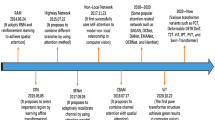Abstract
Biologically motivated attention systems prefilter the visual environment for scene elements that pop out most or match the current system task best. However, the robustness of biological attention systems is difficult to achieve, given e.g., the high variability of scene content, changes in illumination, and scene dynamics. Most computational attention models do not show real time capability or are tested in a controlled indoor environment only. No approach is so far used in the highly dynamic real world scenario car domain. Dealing with such scenarios requires a strong system adaptation capability with respect to changes in the environment. Here, we focus on five conceptual issues crucial for closing the gap between artificial and natural attention systems operating in the real world. We show the feasibility of our approach on vision data from the car domain. The described attention system is part of a biologically motivated advanced driver assistance system running in real time.
Preview
Unable to display preview. Download preview PDF.
Similar content being viewed by others
References
Corbetta, M., Shulman, G.: Control of goal-directed and stimulus-driven attention in the brain. Nature Reviews Neuroscience 3, 201–215 (2002)
Egeth, H.E., Yantis, S.: Visual attention: control, representation, and time course. Annual Review of Psychology 48, 269–297 (1997)
Wolfe, J.M., Horowitz, T.S.: What attributes guide the deployment of visual attention and how do they do it? Nat. Reviews Neuroscience 5(6), 495–501 (2004)
Koch, C., Ullman, S.: Shifts in selective visual attention: towards the underlying neural circuitry. Human Neurobiology 4(4), 219–227 (1985)
Tsotsos, J.K., Culhane, S.M., Wai, W.Y.K., Lai, Y., Davis, N., Nuflo, F.: Modeling visual attention via selective tuning. Artificial Intelligence 78(1-2), 507–545 (1995)
Navalpakkam, V., Itti, L.: Modeling the influence of task on attention. Vision Research 45(2), 205–231 (2005)
Frintrop, S.: VOCUS: A Visual Attention System for Object Detection and Goal-Directed Search. PhD thesis, University of Bonn Germany (2006)
Michalke, T., Gepperth, A., Schneider, M., Fritsch, J., Goerick, C.: Towards a human-like vision system for resource-constrained intelligent cars. In: Int. Conf. on Computer Vision Systems, Bielefeld (2007)
Frintrop, S., Backer, G., Rome, E.: Goal-directed search with a top-down modulated computational attention system. In: DAGM-Symposium, pp. 117–124 (2005)
Itti, L., Koch, C., Niebur, E.: A model of saliency-based visual attention for rapid scene analysis. IEEE Trans. Pattern Anal. Mach. Intell. 20(11), 1254–1259 (1998)
Hardy, R.N.: Homeostasis, Arnold (1983)
Simons, D., Chabris, C.: Gorillas in our midst: Sustained inattentional blindness for dynamic events. British Journal of Developmental Psychology 13, 113–142 (1995)
Trapp, R.: Stereoskopische Korrespondenzbestimmung mit impliziter Detektion von Okklusionen. PhD thesis, University of Paderborn Germany (1998)
Heinke, D., Humphreys, G.: Computational models of visual selective attention: a review. In: Houghton, G. (ed.) Connectionist Models in Psychology, pp. 273–312. Psychology Press (2005)
Frintrop, S., Klodt, M., Rome, E.: A real-time visual attention system using integral images. In: Int. Conf. on Computer Vision Systems, Bielefeld (2007)
BenchmarkData: (2007) http://www.rtr.tu-darmstadt.de/~tmichalk/ICVS2008_BenchmarkData/
Author information
Authors and Affiliations
Editor information
Rights and permissions
Copyright information
© 2008 Springer-Verlag Berlin Heidelberg
About this paper
Cite this paper
Michalke, T., Fritsch, J., Goerick, C. (2008). Enhancing Robustness of a Saliency-Based Attention System for Driver Assistance. In: Gasteratos, A., Vincze, M., Tsotsos, J.K. (eds) Computer Vision Systems. ICVS 2008. Lecture Notes in Computer Science, vol 5008. Springer, Berlin, Heidelberg. https://doi.org/10.1007/978-3-540-79547-6_5
Download citation
DOI: https://doi.org/10.1007/978-3-540-79547-6_5
Publisher Name: Springer, Berlin, Heidelberg
Print ISBN: 978-3-540-79546-9
Online ISBN: 978-3-540-79547-6
eBook Packages: Computer ScienceComputer Science (R0)




